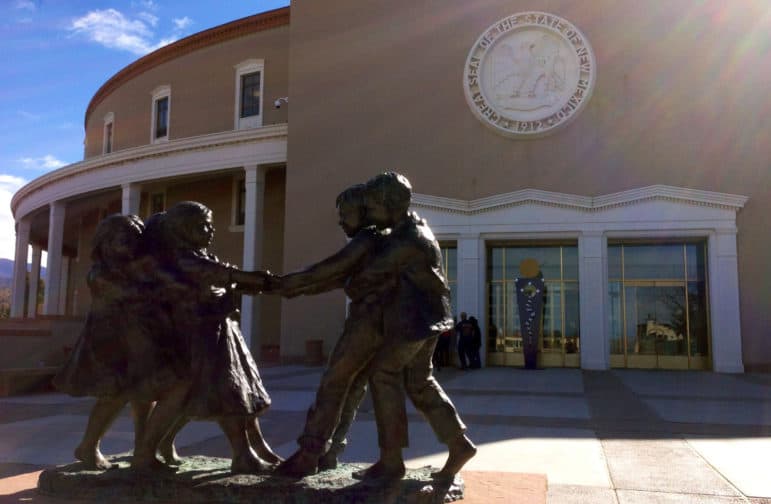
Heath Haussamen / NMPolitics.net
A statue outside the Roundhouse in Santa Fe.
Federal officials have set a Sunday deadline for state political leaders to agree to a compromise that brings New Mexico driver’s licenses into compliance with the REAL ID Act.
That has given new life to the annual battle in the N.M. Legislature over repealing the state’s 2003 law that allows immigrants without legal status to obtain licenses — which is the primary reason New Mexico’s licenses don’t currently comply with REAL ID.
Here’s what you need to know about the issue:
The REAL ID Act
The REAL ID Act, passed by Congress in 2005, lets the federal government set security standards for IDs that can be used for federal purposes such as boarding airplanes and entering military bases. Many states have come into compliance with REAL ID. The feds have granted waivers to New Mexico and other states in the past, but this year have decided to enforce the act in some states, including here.
No matter what happens, you’ll still be able to use your New Mexico license to board a plane, at least for now. The U.S. Department of Homeland Security (DHS) isn’t currently requiring REAL ID compliance at airports, Philip A. McNamara, DHS assistant secretary For Intergovernmental Affairs, wrote in a column published in the Albuquerque Journal in November.
“Right now, no one needs to adjust travel plans, rush out to get a new driver’s license or a passport for domestic air travel. And when you do, we will make sure you have plenty of notice,” McNamara wrote. He promised a warning “at least 120 days” before the feds decide to enforce REAL ID at airports.
What will change in New Mexico starting Sunday if state political leaders don’t agree to a compromise before then? New Mexico licenses may or may not get people into nuclear power plants, military bases, and other federal facilities that require identification. New Mexicans may need to show an alternative form of ID such as a passport.
Some facilities, such as military bases, are setting their own rules for what will be needed to get on base if New Mexico licenses are deemed out of compliance with REAL ID.
What can NM political leaders do?
New Mexico’s lawmakers meet in a 30-day session that begins Jan. 19. They could amend state law to make New Mexico’s licenses REAL ID compliant. Gov. Susana Martinez has agreed to put the topic on the agenda.
But the federal deadline comes nine days earlier. The feds have agreed to give New Mexico a 12-month extension if Martinez and legislative leaders send DHS a letter pledging agreement on legislation that ensures REAL ID compliance.
There’s no compromise yet. Various proposals would create two distinctly different cards that allow people in New Mexico to drive legally — one that is REAL ID complaint and another for people who don’t provide Social Security numbers or other proof of lawful residence.
The Democrats’ proposal
Many Democrats favor shifting to a two-tier licensure system so most people — those who provide proof of legal residence or citizenship — can obtain licenses that will be accepted for federal purposes, and those who don’t can still obtain a second-tier license letting them drive legally in New Mexico.
Three Democratic legislative leaders — Senate President Pro Tem Mary Kay Papen, Senate Majority Leader Michael Sanchez, and House Minority Leader Brian Egolf — sent a letter to Martinez and House Speaker Don Tripp, a Republican, on Monday urging compromise. They cited a bill that passed the Senate in 2015 that would have created a two-tier licensure system.
Under that bill, those who don’t provide proof of citizenship or legal residence would have to provide “an individual tax identification number, a passport or ID from the individual’s country of origin, or other documentation that the secretary of (the state’s Taxation and Revenue Department) has authorized as an acceptable substitute” to obtain a second-tier license. The impact of those requirements on people without legal status who already have New Mexico licenses isn’t clear — but they could result in some people without legal status who currently have licenses losing them.
The Republicans’ proposal
Republicans have proposed even stricter requirements that would likely strip some current license holders of their ability to drive legally. Tripp sent his own letter to Sanchez on Tuesday laying out the GOP proposal. The main difference is that people would have to show evidence that they have lived in New Mexico for at least two years and filed personal income taxes with the state in the previous year to obtain the second-tier license.
Tripp cited Utah as among the states that have such a system in place. But Utah’s requirements for those without legal status to obtain a so-called driving privilege card don’t include proof of two years of residency or having filed a tax return.
What now?
State legislative leaders and the governor have until Sunday to resolve their dispute and send a letter to DHS stating that they’ve agreed to a REAL ID compliant solution, or DHS has said it won’t grant another one-year extension.
If the political leaders come to an agreement, they’ll have to pass a bill through the Legislature. Then the state would have approximately 11-12 months to implement the new system before the REAL ID compliance extension would expire.
If political leaders don’t come to an agreement, and DHS makes good on its promise to not grant another REAL ID extension, New Mexicans may need to show an alternative form of ID to get into some federal facilities that require identification starting next week.